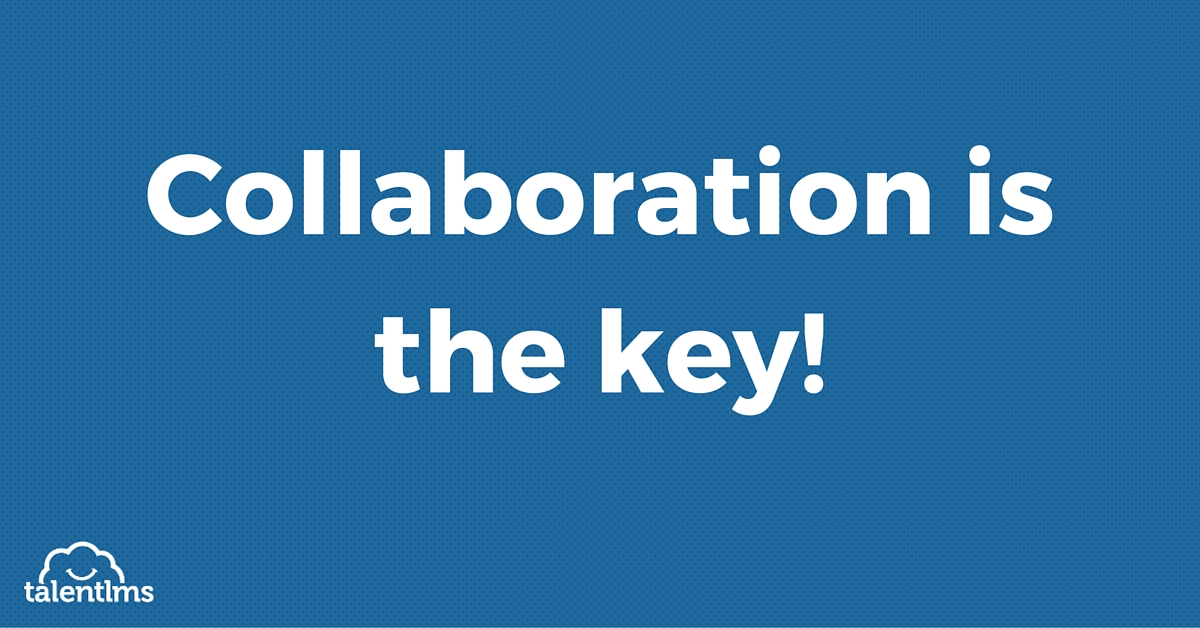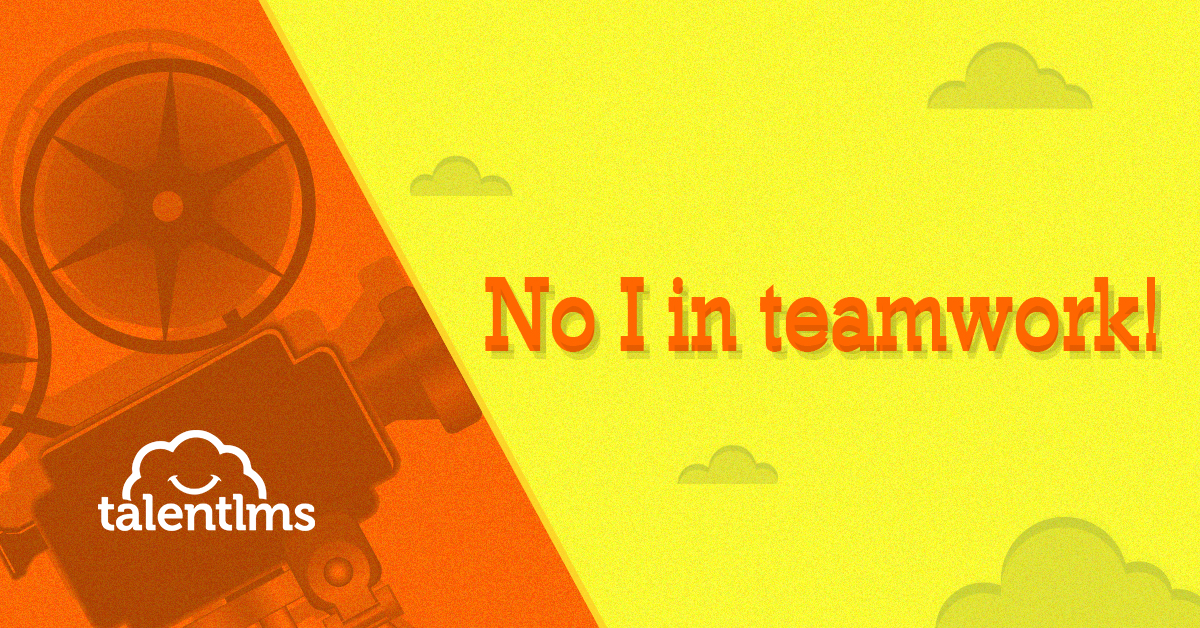- What is collaborative learning?
- Why is collaborative learning important in the workplace?
- What are the benefits of collaborative learning–for companies and employees?
- Collaborative learning activities in the workplace
- Common challenges in implementing cooperative learning
- How to foster a collaborative learning culture at work
- 12 Questions to ask before using collaborative learning
- Collaborative learning works wonders
Without collaboration, learning can be incomplete, as it is an inherently social process. Online collaborative learning can do wonders, most specifically in remote settings. Why is that?
Instructors can become overwhelmed when it comes to engaging course participants. With learners being more and more unique, challenging, and intellectually advanced, instructors can run out of strategies to engage them.
But collaborative learning works wonders. It connects learners across distances, allowing them to tap into each other’s strengths, share diverse perspectives, and create a dynamic, supportive learning community that keeps everyone engaged and growing together.
What is collaborative learning?
Collaborative learning is an eLearning approach where learners can socially interact with other learners and instructors. In essence, people work together to expand their knowledge of a particular subject or skill. In eLearning and remote work environments, this is typically done through live chats, message boards, videoconferencing, or instant messaging.
This online method of learning can also be conducted offline, this is why it can be done both asynchronously or synchronously. It allows people to learn from the ideas, skill sets, and experiences of others enrolled in the course. By engaging in a shared task (whether it be a project or lesson) learners gain the opportunity to discover a variety of skills, such as group analysis and collaborative teamwork skills.
In addition, even remote learners who are unable to attend a live event can always participate in online collaborative learning, thanks to online forums, message boards, and other tools that don’t rely on real-time interaction.
Why is collaborative learning important in the workplace?
Collaborative learning is a must-have in today’s workplace.
The days of sitting through a lecture, half-listening, and then forgetting everything by the next morning are long gone. Today, learning at work must be active, engaging, and—most importantly—collaborative.
Here’s why this approach isn’t just a nice-to-have, but a total game-changer:
It brings fresh perspectives to the table
When people with different backgrounds, skills, and experiences come together, magic happens.
In “Supercharging your workplace learning culture,” by TalentLMS’ podcast series, Keep it Simple, Andy Lancaster claims that the best groups are often made up of people who see things differently, as this helps everyone learn from new ideas and perspectives.
Collaborative learning taps into collective brainpower, helping teams innovate and come up with solutions that would be impossible from one person.
It gets everyone involved
There’s no room for zoning out in collaborative learning sessions. Everyone’s voice matters. Each person has a chance to share their insights and contribute.
This type of active learning keeps people engaged, sharp, and ready to roll. Employees are more hands-on, more connected, and more invested in what they’re learning.
It’s learning you can use right away
What’s the point of learning if you can’t use it? That’s where collaborative learning really shines.
It’s about practical, real-world situations that people can apply immediately. When teams collaborate, they’re already solving work-related issues, so the learning happens in the moment and makes a difference in real time.
It builds critical thinking muscles
In collaborative environments, people are continuously thinking, questioning, and challenging.
This builds critical thinking skills that are essential in today’s modern work environments. It motivates everyone to dig deeper, think smarter, and come up with solutions that really stick.
It strengthens team bonds
Great teams get more done.
Collaborative learning helps teams understand each other’s strengths, improve communication, and work better together. It’s like team building plus real learning and growth.
Andy supports “If we study what ecosystems are, it’s about organisms living effectively with each other, very often, very different organisms, and recognizing that kind of symbiotic thing where when we balance and when we complement each other”. This kind of collaboration is the foundation of a thriving work culture that values diversity and synergy.
It keeps everyone learning, all the time
Learning isn’t a one-and-done situation anymore.
Industries and technologies evolve really fast, so employees need to focus on upskilling and reskilling. Collaborative training platforms make it easy for teams to learn together anytime, anywhere. This way, employees stay sharp, adaptable, and ahead of the curve.
It supercharges skill development
Learning together speeds up skill building.
In a collaborative learning environment, employees actively practice, get real-time feedback, and sharpen both technical and soft skills. Working together turns ideas into practical abilities and naturally builds adaptability and collaboration.
Meet TalentLibrary™
A growing collection of ready-made courses that cover the soft skills
your teams need for success at work![]()

What are the benefits of collaborative learning–for companies and employees?
People can see things from a different perspective through collaborative learning. But this eLearning approach can also greatly benefit both your employees and your organization as a whole. Fostering a learning culture in which employees can also build their social skills really does wonders for your business.
Let’s see in detail some of the benefits of collaborative learning for companies and employees.
1. Soft skill development
It goes without saying that online collaborative learning involves teamwork. Learners need to work together towards a common goal. This results in enriching essential collaborative skills like communication, conflict resolution, and even leadership abilities. And this is one of the key benefits of collaborative learning.
At the same time, collaborative learning sharpens project management skills while learners delegate responsibilities and rely on time management. So , without spending too much time and effort, you nurture future managers and supervisors with a boost to their skills ,right from the start.
2. Faster project completion
Time is money, and what’s better than completing projects in a shorter period of time? Online collaboration fosters a culture of teamwork which leads to finalizing tasks and projects faster. By working together, employees learn to run online meetings with videoconferencing tools, connecting not just with their own team but also with others across departments. This sharing of ideas and expertise sparks creativity, leading to smarter solutions and faster project completion.
3. Better engagement and participation
Humans are extremely social and value interaction. In the remote workplace, social interaction is important so that people don’t feel isolated. Online collaborative learning gives the opportunity to people to communicate and share life experiences which can lead to improving engagement and participation. Imagine how closed social media groups can help form stronger bonds between learners and really engage them in training.
4.Controls limiting beliefs
Sometimes, personal beliefs can hinder the learning process. When people learn on their own, they developm only up to a certain level based on what they understand, their culture, or previous experiences and assumptions. On the contrary, by collaborating with peers, people learn together as they share ideas and opinions. Online collaborative learning brings people together and allows them to re-evaluate their limiting beliefs. They look at every interaction as an opportunity to discover more about their group members and get people thinking to overcome any preconceived notions.
Collaborative learning activities in the workplace
77% of employees believe it’s essential for their companies to offer training that provides career and development opportunities in 2024, so that they can transition into new roles. People want to learn, they want to upskill and reskill. And it’s best when done collaboratively.
Collaborative learning strategies and models that work
There are proven methods that make collaborative learning activities truly effective. Let’s take a closer look at the most popular ones:
Jigsaw method
Think of it like solving a puzzle together. Each of the group members is responsible for mastering a piece of the topic and then teaching it to their peers. This strategy ensures that everyone contributes and learns from each other, making the learning experience richer and more engaging. It perfectly blends accountability and teamwork, key ingredients for fostering collaborative learning.
Think-Pair-Share
Individuals first think about a topic or a problem. Then, they pair up to discuss their ideas, and finally share their insights with other cooperative learning groups. This method encourages both critical thinking and active participation, giving everyone the chance to reflect and contribute. Also, these sessions help quieter team members feel more comfortable voicing their thoughts. As a result, discussions become more diverse and well-rounded.
Group problem solving
One of the best ways to encourage learning is by solving real-world problems in teams. These activities engage employees in hands-on collaborative learning where they can tackle challenges as a team. This method improves critical thinking and strengthens teamwork, communication, and the ability to think on your feet.

Common challenges in implementing cooperative learning
While collaborative learning transforms the way teams work, it doesn’t come without its own set of hurdles. Here are some common challenges that companies often face.
Different learning styles and comfort levels
Not everyone is comfortable with group learning. Some people prefer to work independently or struggle to share their ideas in a team setting. This can make collaboration feel awkward or forced. Ensuring everyone feels included and valued during the collaborative and cooperative learning process can be challenging.
Time management and scheduling conflicts
Workplaces are usually very busy. So, finding the time for collaborative learning can be tough. Coordinating schedules for meetings, group discussions, and collaborative training often feels like herding cats. Balancing learning initiatives with daily tasks and deadlines might make it hard to prioritize cooperative learning. Especially when employees are stretched thin.
Andy highlights, “Most communities that work well have a rhythm—a cadence.” This suggests that well-organized collaboration allows for effective scheduling and continuous engagement.
Technology and tool barriers
In remote or hybrid settings, having the right tech is critical for learning through collaboration. If employees don’t have access to the right training platform or if it’s not user-friendly, there’s a risk of frustration and disengagement. Technical hiccups like connectivity issues or poor training on using tools might seriously derail your cooperative learning efforts.
How to foster a collaborative learning culture at work
Creating a collaborative learning culture doesn’t happen overnight. It requires intentional strategies, the right environment, and a mindset shift across the organization.
Here’s how companies can successfully foster a culture where collaborative learning thrives:
Lead by example
Collaboration starts at the very top.
Leadership should model collaborative behaviors like open communication, knowledge sharing, and working together toward goals. This sends a strong message to the rest of the organization.
“Leadership and management is so crucial in this one… it’s so crucial for managers to be aware of it and involved,” emphasizes Andy.
Managers and execs should also actively participate in collaborative learning initiatives as well as engage in collaborative training activities. Plus, they should demonstrate continuously that active learning is a continuous, team-based process. As employees see leadership valuing and being a part of collaboration, they are more likely to follow suit.
Encourage cross-department collaboration
Silos are one of the biggest obstacles to creating a collaborative learning culture.
Break them down and encourage knowledge sharing. To achieve this, invest in cross-departmental projects and collaborative learning activities that bring together people from various teams. Employees will understand how different areas of the company work. This will also boost innovation by sharing diverse ideas and skills that might not emerge within a single team.
Use the right tools
The right tools are key for fostering a collaborative learning environment, especially in remote or hybrid work settings.
A robust LMS, Microsoft Teams, Slack, and other collaboration platforms like Miro or Trello are useful virtual spaces for employees to brainstorm, share resources, and work together seamlessly. However, make sure that your LMS supports various training formats so that you can easily structure team learning activities, track progress, and offer both synchronous and asynchronous learning options to keep collaboration productive.
Create structured collaborative learning programs
Without structure, learning can fall short, as it might lack clear objectives.
Develop well-defined programs with specific goals, roles, and timelines for effective collaborative learning sessions. This framework ensures that everyone is on the same page and understands the purpose behind each activity. Collaboration becomes more meaningful and focused. Moreover, a clear structure means having measurable outcomes. So, you can help employees see the true impact of their learning efforts and keep them motivated.
12 Questions to ask before using collaborative learning
The best eLearning courses are usually the ones that have been improved in iterations. The answers to these questions are one of the fastest methods to achieve higher quality courses. Ready to improve your online collaborative learning? Here are a few essential questions to guide you.
1. What is the content of this course?
What areas of this content encourage collaborative learning? What areas are surplus? Some pieces of content may need to go, no matter how important they seem. There is a place for the surplus (and seemingly worthwhile) content, and that is the “Resources and Extra Reading” section. Have learners review this section by providing direct links after the main content. But try not to clutter your course.
2. What are the goals of the small group activities already established for this course?
Do they lead to rich collaborative environments? The best way to ensure that collaboration will be successful is to merge the course goals with your current registered learners’ goals.
3. What are optimal team sizes for efficient eLearning collaboration?
Based on the age groups of your learners and their competency level, create appropriate team sizes and composition to ensure that cooperative learning actually happens in the desired manner and is an improvement.
4. How are groups or teams formed?
Are they formed by the trainer or by the learners themselves? Are they formed based on interests or strengths? Responding to these questions will yield better and more satisfying learning experiences.
5. Should teams be homogeneous or heterogeneous?
Research suggests a JIGSAW-style group formation in which high-capability individuals are mixed with lower-capability ones. This creates a culture of helping, caring, and inspiration, and helps all learners learn better.
6. Do the groups remain the same throughout the course?
Or does each activity require different groups? If the course is short, try maintaining the teams throughout the cooperative learning course. Longer courses can benefit from group members’ shifts. It will help instill better team spirit and leadership skills.
7. How will activities be structured to ensure participation?
Everyone needs a chance to express themselves. When learners submit their ideas and opinions on discussion boards, try to analyze the strengths of each. Create activities that everybody can relate to, identify with, and contribute towards.
8. Do the group dynamics lend themselves to labeling groups or individuals with roles?
Identify strong characteristics of your learners and provide roles to them. This way, the peers are more likely to benefit from each other and actually learn more efficiently.
9. Are there any rewards and motivations built into the course?
Think of adding gamification techniques, like points or badges awarded to all members of a group that succeed in a given task.
10. Is there accountability built into the course?
Have learners contribute towards rule-making activities. Let them brainstorm and decide how assignments X Y, Z will be scored, for example. Give them choices and responsibilities. This will involve them even more in the cooperative learning course, and facilitate active learning.
11. How will the evaluation of individuals and groups take place?
Is the evaluation completed by the trainer or by the learners? You can have both learners and instructors evaluate progress for a more well-rounded approach. For example, learners can evaluate their peers by giving feedback while working on a group project or assignment. Instructors can then add to this feedback session and evaluate the final results of a project or an assignment. Or, make it clear from the beginning that only learners or instructors will be evaluating the learners’ progress.
12. How will feedback on performance be provided?
Will it be completed by peers or by the trainer? Or perhaps by both? The importance of feedback in eLearning is indisputable, as it helps the learners improve their performance, whether provided by their peers or the instructor.
Collaborative learning works wonders
Establishing collaboration in the learning process is an explicit and deliberate effort. It needs prior planning. Sometimes, collaboration plans need to change according to the group responses.
Have a meeting with the eLearning development team to discuss your answers and those of your learners to these questions.
You’ll be amazed at how collaborative learning encourages regular communication, deeper connections, and creativity between learners. As people share ideas and learn together, skills grow faster, and the whole learning experience becomes fun and rewarding.
The more people collaborate, the more they thrive.
Originally published on: 10 Oct 2016 | Tags: Online Training,Social Learning,Virtual Teams





